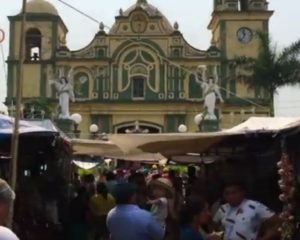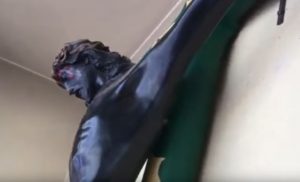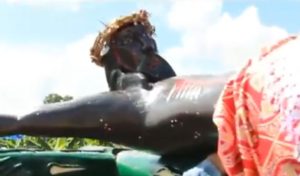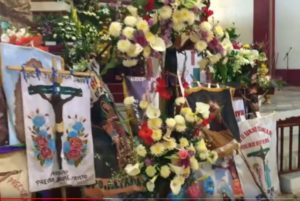Podcast: Play in new window | Download
Subscribe: Apple Podcasts | RSS
 From the 1920s and into the 1930s the country of Mexico was in the grips of the Cristero War. The war pit pro-Catholic forces against those of secular politicians who wanted a strict separation of church and state in accordance with the 1917 constitution. On September 8, 1931, a group of anti-Catholics under the direction of the governor of the Mexican state of Veracruz – Adalberto Tejeda – broke into the small church of San Andrés Apóstol in the town of Otatitlán. Their goal was the removal and destruction of the prime object of veneration at that small church: A black crucified Christ. Called the Cristo Negro de Otatitlán, the black carving had been the subject of countless pilgrimages over the centuries and had been credited with working an untold number of miracles. The armed men removed the cristo to the tears and protests of the townsfolk. It was carried away to someplace out of town. Although the carving was made of centuries-old wood, when the men tried to burn it, it did not catch fire. Even after emptying an entire can of gasoline on the black image of the crucified Christ, it would not burn. Exasperated, the men took a hack saw and cut off the carving’s head, leaving the decapitated body behind. The faithful waited for the pro-Tejeda forces to leave town before they rescued their precious relic which was now headless but otherwise unharmed. The fact that the cristo could not burn was evidence to the faithful of a miraculous sign from Heaven. They brought it back to the church. By the end of 1931 masses were suspended in Otatitlán. The government ordered the parish priest arrested and the church locked. In 1932 the annual fiesta to celebrate the Black Christ of Otatitlán was suspended by the Tejeda government. When the Veracruz secular authorities lifted all religious restrictions in 1933, the Church of San Andrés Apóstol re-opened to the public and the veneration and annual fiesta resumed. An artist named Olaguibel carved another head and it perfectly matched the head that was sawed off. The original head of the sculpture mysteriously appeared at the front of the door of the church sometime in 1950 and was restored to the cristo. To this day, Olaguibel’s replacement head is on view under glass at the San Andrés Apóstol church in Otatitlán.
From the 1920s and into the 1930s the country of Mexico was in the grips of the Cristero War. The war pit pro-Catholic forces against those of secular politicians who wanted a strict separation of church and state in accordance with the 1917 constitution. On September 8, 1931, a group of anti-Catholics under the direction of the governor of the Mexican state of Veracruz – Adalberto Tejeda – broke into the small church of San Andrés Apóstol in the town of Otatitlán. Their goal was the removal and destruction of the prime object of veneration at that small church: A black crucified Christ. Called the Cristo Negro de Otatitlán, the black carving had been the subject of countless pilgrimages over the centuries and had been credited with working an untold number of miracles. The armed men removed the cristo to the tears and protests of the townsfolk. It was carried away to someplace out of town. Although the carving was made of centuries-old wood, when the men tried to burn it, it did not catch fire. Even after emptying an entire can of gasoline on the black image of the crucified Christ, it would not burn. Exasperated, the men took a hack saw and cut off the carving’s head, leaving the decapitated body behind. The faithful waited for the pro-Tejeda forces to leave town before they rescued their precious relic which was now headless but otherwise unharmed. The fact that the cristo could not burn was evidence to the faithful of a miraculous sign from Heaven. They brought it back to the church. By the end of 1931 masses were suspended in Otatitlán. The government ordered the parish priest arrested and the church locked. In 1932 the annual fiesta to celebrate the Black Christ of Otatitlán was suspended by the Tejeda government. When the Veracruz secular authorities lifted all religious restrictions in 1933, the Church of San Andrés Apóstol re-opened to the public and the veneration and annual fiesta resumed. An artist named Olaguibel carved another head and it perfectly matched the head that was sawed off. The original head of the sculpture mysteriously appeared at the front of the door of the church sometime in 1950 and was restored to the cristo. To this day, Olaguibel’s replacement head is on view under glass at the San Andrés Apóstol church in Otatitlán.
There are two stories involving how the Black Christ ended up in Otatitlán. Both are promoted by the church and it is up to the individual to discern which one could be the real story.
The first story takes place a little upriver from Otatitlán. It can be traced to a document written in 1746 by José Villaseñor y Sánchez who collected testimonies and looked into the archives at the Otatitlán church. According to this version of the story, two mysterious travelers showed up at the house of a local indigenous man sometime in the 1590s. The travelers saw that the man had a large piece of cedar and asked if they could use that cedar block to make a carving of Christ since they were expert carvers. The indigenous man agreed. The next morning when the man awoke that block of wood was now something else. It had been carved into the Black Christ overnight by the two strangers. They also left behind food and pieces of silver as gifts for the man. No one in the village had ever seen these two men before and immediately people claimed that they were angels disguised as men. The cristo traveled from village to village before finding a more permanent home at San Andrés Apóstol in Otatitlán.
 The second origin story gives the cristo carving a more earthly provenance. This story comes from the writings of Antonio de Alcedo y Bejarano, a soldier and scholar, and the son of a Spanish colonial official who was posted to various locations in the New World. Alcedo himself was born outside of Quito in what is now Ecuador but traveled throughout the Spanish possessions in the Americas. Between 1786 and 1789 Alcedo wrote a massive 5-volume encyclopedia about the New World. He combined his firsthand experience with over 300 sources he compiled over 20 years. The sources ranged from church documents and diaries of individual clergy members, to bland government records and papers from military archives. Alcedo’s great work was so comprehensive and so detailed that the King of Spain, Charles the Fourth, prohibited export of the book from Spain for fear of giving enemy nations vital information of His Majesty’s overseas territories. In his encyclopedia Alcedo references the Black Christ of Otatitlán and mentions that it was one of three darker Jesus images that were sent to the New World at the same time in the late 1590s. The other carvings went to Espuipulas in modern-day Guatemala and to Chalma located in the modern Mexican state of México. For more about the Black Christ of Chalma, please see Mexico Unexplained Episode Number 40: https://mexicounexplained.com//black-christ-chalma/ Alcedo notes in his encyclopedia that in September of 1595 the king of Spain, Phillip the Second, commissioned an artist named Juan Donnier to carve the three black Christs. The price for each was 6,900 Marks. The sculptures were delivered to the court at Madrid on January 9, 1596 and then sent to New Spain. On April 20, 1596, the sculptures arrived at the Veracruz port of Villa Rica and went their separate ways. The one destined for Otatitlán arrived at the mouth of the Papaloapan River two days later for its journey upstream. On April 28, 1596 the cristo arrived at Puctlancingo, a place where missionaries were in the process of converting the indigenous locals. It remained there until February of 1597. At that time an epidemic of smallpox wiped out most of the population of Puctlancingo and the survivors moved to the small Spanish settlement called San Andrés Apóstol also known by its indigenous name of Otatitlán, which may mean either “The Place of the Tamarind Trees” or “The Place of the Bendable Bamboo.” The sculpture immediately attracted pilgrims and helped convert the remaining natives in the region to Christianity. The cristo remained in the church of San Andrés Apóstol until it was moved to the town of Chacaltianguis in 1838 for two years. Since 1840 it has remained in Otatitlán.
The second origin story gives the cristo carving a more earthly provenance. This story comes from the writings of Antonio de Alcedo y Bejarano, a soldier and scholar, and the son of a Spanish colonial official who was posted to various locations in the New World. Alcedo himself was born outside of Quito in what is now Ecuador but traveled throughout the Spanish possessions in the Americas. Between 1786 and 1789 Alcedo wrote a massive 5-volume encyclopedia about the New World. He combined his firsthand experience with over 300 sources he compiled over 20 years. The sources ranged from church documents and diaries of individual clergy members, to bland government records and papers from military archives. Alcedo’s great work was so comprehensive and so detailed that the King of Spain, Charles the Fourth, prohibited export of the book from Spain for fear of giving enemy nations vital information of His Majesty’s overseas territories. In his encyclopedia Alcedo references the Black Christ of Otatitlán and mentions that it was one of three darker Jesus images that were sent to the New World at the same time in the late 1590s. The other carvings went to Espuipulas in modern-day Guatemala and to Chalma located in the modern Mexican state of México. For more about the Black Christ of Chalma, please see Mexico Unexplained Episode Number 40: https://mexicounexplained.com//black-christ-chalma/ Alcedo notes in his encyclopedia that in September of 1595 the king of Spain, Phillip the Second, commissioned an artist named Juan Donnier to carve the three black Christs. The price for each was 6,900 Marks. The sculptures were delivered to the court at Madrid on January 9, 1596 and then sent to New Spain. On April 20, 1596, the sculptures arrived at the Veracruz port of Villa Rica and went their separate ways. The one destined for Otatitlán arrived at the mouth of the Papaloapan River two days later for its journey upstream. On April 28, 1596 the cristo arrived at Puctlancingo, a place where missionaries were in the process of converting the indigenous locals. It remained there until February of 1597. At that time an epidemic of smallpox wiped out most of the population of Puctlancingo and the survivors moved to the small Spanish settlement called San Andrés Apóstol also known by its indigenous name of Otatitlán, which may mean either “The Place of the Tamarind Trees” or “The Place of the Bendable Bamboo.” The sculpture immediately attracted pilgrims and helped convert the remaining natives in the region to Christianity. The cristo remained in the church of San Andrés Apóstol until it was moved to the town of Chacaltianguis in 1838 for two years. Since 1840 it has remained in Otatitlán.
 Why was the image of Jesus black? Why were these three special Christ statues sent to these three specific areas? Guatemalan anthropologist and writer Carlos Navarrete has an interesting theory regarding the complexion and placement of these carvings. He noticed that the Spanish installed all three of these dark cristos at key spots in ancient overland trading routes of the pochteca, the class of Aztec traveling merchants which connected far-flung parts of Mesoamerica through commerce. For more information about the pochteca, please see Mexico Unexplained episode number 102: https://mexicounexplained.com//pochteca-aztec-traders-aztec-spies/ The commission to create the black Christ statues came from the highest levels of the Spanish government. The king and his advisors knew what they were doing. A few generations after the Spanish Conquest many indigenous people throughout New Spain were starting to question Catholicism. They were becoming curious about their ancient religions, the belief systems of their grandparents and great-grandparents. In some parts of the Spanish Americas the clergy felt their hold slowly slipping. How could the Spanish strengthen the church’s position in its colonies? The answer to that question varied depending on the region and the circumstances. If Navarrete’s theory is correct, the three black Christs not only went to strategic areas, the black color of the statues was very intentional. As previously mentioned, these three places, Chalma, Esquipulas and Otatitlán were important way stations or hubs on the old overland trading routes. As such, they were also sites that included pre-existing shrines, shrines to the dark-colored god of trade and travelers called Yacatecuhtli.
Why was the image of Jesus black? Why were these three special Christ statues sent to these three specific areas? Guatemalan anthropologist and writer Carlos Navarrete has an interesting theory regarding the complexion and placement of these carvings. He noticed that the Spanish installed all three of these dark cristos at key spots in ancient overland trading routes of the pochteca, the class of Aztec traveling merchants which connected far-flung parts of Mesoamerica through commerce. For more information about the pochteca, please see Mexico Unexplained episode number 102: https://mexicounexplained.com//pochteca-aztec-traders-aztec-spies/ The commission to create the black Christ statues came from the highest levels of the Spanish government. The king and his advisors knew what they were doing. A few generations after the Spanish Conquest many indigenous people throughout New Spain were starting to question Catholicism. They were becoming curious about their ancient religions, the belief systems of their grandparents and great-grandparents. In some parts of the Spanish Americas the clergy felt their hold slowly slipping. How could the Spanish strengthen the church’s position in its colonies? The answer to that question varied depending on the region and the circumstances. If Navarrete’s theory is correct, the three black Christs not only went to strategic areas, the black color of the statues was very intentional. As previously mentioned, these three places, Chalma, Esquipulas and Otatitlán were important way stations or hubs on the old overland trading routes. As such, they were also sites that included pre-existing shrines, shrines to the dark-colored god of trade and travelers called Yacatecuhtli.
In the language of the Aztecs, Nahuatl, “Yacatecuhtli” combines two words, yacatl, which means “nose” in English, and tecuhtli which means lord. So, this god’s name literally means “lord of the noses.” It was said that the god could sniff out bargains and he used his nose to point the traveling merchants in the right direction in their journeys. The god was worshipped wherever merchants stopped for the night, so key places on the trade routes has small shrines to Yacatecuhtli. Before turning in for the evening, merchants would bundle together sticks and put blood from their earlobes on the bundles as offerings to the god for nighttime protection from bandits and predatory wild animals. In iconography Yacatecuhtli was often depicted as being dark-skinned. He was also portrayed as carrying a large cross on his back, to symbolize the four directions. It’s no wonder that when the carved black figures of the crucified Christ arrived at the three destinations that the locals became instant devotees and converts. The Spanish had used the former beliefs present in these three areas and brought a new god that was easy for the indigenous people to digest. This was not the first nor the last time that Christianity slightly bended to local traditions in order to solidify its own power over a newly converted population. Anthropologists call this blending of old and new beliefs “syncretism.” This is why we have an Easter bunny and why people decorate Christmas trees with brightly colored bulbs to celebrate the birth of Christ.
 Even more than four centuries later, some syncretism still exists, and indigenous traditions survive in connection with festivities surrounding the Black Christ of Otatitlán. After the mass to honor the cristo it is not uncommon for a Mazatec shaman to perform a cleansing ritual in the streets of the town. Besides the indigenous undertones, the celebrations for this important devotional object are pretty typical Mexican fiesta fare. The major feast day for Black Christ of Otatitlán is May 3rd, which also coincides with the Day of the Cross on the Latin American liturgical calendar. Festivities in this town of 5,000 people usually begin on April 28th and end on May 7th. Over the course of the 10 days of the fiesta some 150,000 people attend the various events connected to the celebration. Pilgrims come mostly from the states of Veracruz and Oaxaca, but the entire nation of Mexico is represented among the multitude of attendees. In a tradition that started with the 400th anniversary of the Black Christ of Otatitlán in 1997, every year the statue is taken overland 15 kilometers between the states of Oaxaca and Veracruz. At the end of the 15-kilometer procession, the cristo is placed on a large raft and floated down the Papaloapan River much as it did in its early days during its first move from Puctlancingo to Otatitlán. Devotees follow along in small boats or swim partway. Since it often rains during that time of year in that part of Mexico, the Black Christ is often traveling under several sheets of plastic. Like many other saints and virgins in Mexico, the Black Christ of Otatitlán is credited with many miracles. Throughout the year, thousands of people travel from many miles to visit the shrine in this small town to give thanks to this incredible image or perhaps to seek a miracle of their own.
Even more than four centuries later, some syncretism still exists, and indigenous traditions survive in connection with festivities surrounding the Black Christ of Otatitlán. After the mass to honor the cristo it is not uncommon for a Mazatec shaman to perform a cleansing ritual in the streets of the town. Besides the indigenous undertones, the celebrations for this important devotional object are pretty typical Mexican fiesta fare. The major feast day for Black Christ of Otatitlán is May 3rd, which also coincides with the Day of the Cross on the Latin American liturgical calendar. Festivities in this town of 5,000 people usually begin on April 28th and end on May 7th. Over the course of the 10 days of the fiesta some 150,000 people attend the various events connected to the celebration. Pilgrims come mostly from the states of Veracruz and Oaxaca, but the entire nation of Mexico is represented among the multitude of attendees. In a tradition that started with the 400th anniversary of the Black Christ of Otatitlán in 1997, every year the statue is taken overland 15 kilometers between the states of Oaxaca and Veracruz. At the end of the 15-kilometer procession, the cristo is placed on a large raft and floated down the Papaloapan River much as it did in its early days during its first move from Puctlancingo to Otatitlán. Devotees follow along in small boats or swim partway. Since it often rains during that time of year in that part of Mexico, the Black Christ is often traveling under several sheets of plastic. Like many other saints and virgins in Mexico, the Black Christ of Otatitlán is credited with many miracles. Throughout the year, thousands of people travel from many miles to visit the shrine in this small town to give thanks to this incredible image or perhaps to seek a miracle of their own.
REFERENCES
Calor Noticias website (in Spanish)
Occult World website
